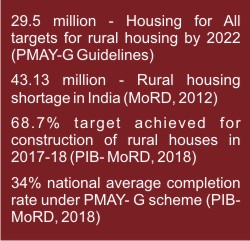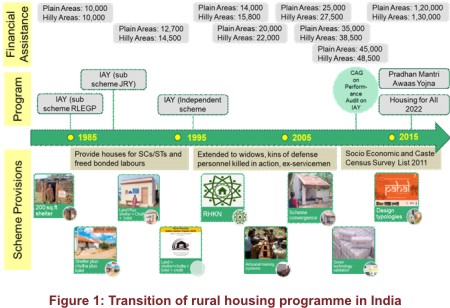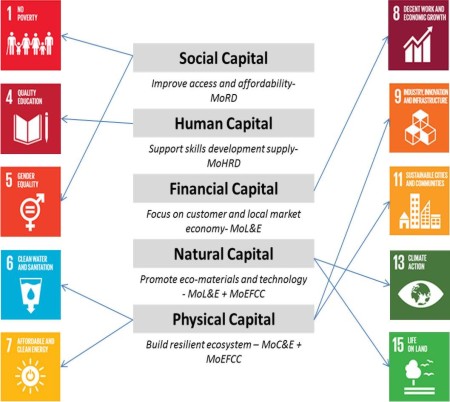|
Sustainable Rural Habitat:
1. Context 1.1. Rural housing in India Public housing programme in the country started with the rehabilitation of refugees immediately after independence and since then, it has been a major focus area of the government as an instrument of poverty alleviation. Started in 1985 as part of the Rural Landless Employment Guarantee Programme (RLEGP), Indira Awaas Yojana (IAY) was subsumed in Jawahar Rozgar Yojana (JRY) in 1989 and has been operating as an independent scheme since 1996. From serving rehabilitation refugees to providing environmentally safe and secure houses, the housing programme has undergone a major shift as shown in Figure 1.
The Government of India under the housing
flagship programme “Housing for All” by 2022, has implemented Pradhan
Mantri Awaas Yojna - Gramin (PMAY-G) w.e.f. 1st April 2016 to provide
environmentally safe and secure houses, with basic amenities to all
houseless and dilapidated households by 2022. This is a huge task,
especially for r To achieve the objective of “Housing for All” the Department of Rural Development has given a target of 10.2 million houses by 2019. Against the target of 5.1 million houses in 2017-18, a total of 3.5 million houses were completed (68.7%). At a national level, completion of homes against target still remains at 34%. The top 3 states are Uttar Pradesh (85%), Chhatisgrah (47%) and Madhya Pradesh (45%). To meet the overall target of “Housing for All” by 2022, material and human resources will be required at an unprecedented scale of not less than 5 million a year. While India aims for timely completion of houses, sustainable construction of houses still remains a big challenge. Monitoring the sustainable construction of houses is an even bigger challenge. 1.2. Shift from housing to habitat lens
In order to achieve the goals that India has
set for itself in rural housing, there is a need to adopt the
sustainable habitat development approach. For this, there is a need to
shift the lens of evaluation and monitoring from ‘housing lens’ to
‘habitat lens’. To explain this further, if the housing lens is considered, PMAY-G aims at providing a pucca house, with basic amenities, to all houseless householders and those households living in kutcha and dilapidated houses by 2022. The aim in this case is to build as many pucca houses as possible to achieve the targets. Now, if we consider the habitat lens, all aspects of housing, along with basic amenities and other public infrastructure will be taken into consideration while trying to achieve the targets. Apart from housing, the focus will also be on sanitation, clean water, domestic energy amenities, public infrastructure, community facilities, livelihood space and its associated infrastructure. The table on the next page shows the link of rural housing with 5 other capitals and highlights other aspects which enable sustainable habitat development. 1.3. Diversity and segmentation It is very important to understand the diversity and segmentation that exists in our society. In 1985 when the rural housing programme was conceptualised, there was an urgent need to cater to the population below poverty line. As India progressed, socio- economic patterns also changed. Population in the poorest category kept on reducing and population in the poor and middle-income group kept on increasing.
Here, it is important to realise that the
current rural housing programme must focus on addressing the needs of
this new emerging income group, which has grown almost 6 times since
1985. From past experiences it has been seen that some people from this
group have taken the initiative to do mason training programmes to
become skilled in green construction practices and also become
entrepreneurs to produce eco friendly building materials following the
quality control guidelines of the states. These masons and entrepreneurs
not only boost the local economy of the place but also generate their
own sources of income and help the poorest income group to build a
resilient habitat. In this way an ecosystem is created for sustainable
rural habitat development. 1.4. Ecosystem mapping of rural habitat In order to successfully deliver sustainable rural habitats, there is need to focus on 4 key elements: delivery mechanism of green technologies, capacity building of artisans and communities, market creation and institutional linkages for eco-friendly building products aggregation and the availability of appropriate credit and support to enhance the demand. At the local level, the major stakeholders involved are techno-social institutions, financial institutions, artisans’ guilds and local entrepreneurs for supply of materials. Sometimes the challenges faced on the ground are not addressed at the state/ centre level as similar stakeholders lack cohesive working at the policy level. Ministry of Micro, Small & Medium Enterprises, National Housing Bank, Construction Skill Development Council of India and other techno-social institutions can work cohesively with MoRD to realise the goal of Housing for All 2022. 2. Measuring What Matters Rural housing has been mapped against various indicators for Sustainable Development Goals. Rural housing has been seen contributing to 10 SDGs. Recommendations It is essential that in order to effectively realise the goal of “Housing for All” by 2022, there is a need for focussing on habitat development instead of just providing houses. Also new methods of measuring what matters the most like safe disaster resilient shelters, efficient use of raw materials etc should be developed and used. Above all, it is crucial that support should be provided by all the government ministries at the state and centre level and also local bodies at the block and district level for the last mile delivery of services. ■
Srijani Hazra
References: |
 ural
areas given the significant size of rural population living in deprived
conditions.
ural
areas given the significant size of rural population living in deprived
conditions.
